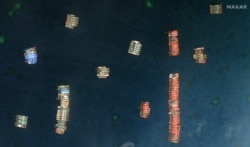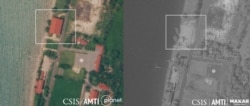Vietnam has created an armed maritime militia unit in a province bordering Kampot, according to a Vietnamese military mouthpiece, which analysts say is a counteract China’s potential military presence at Ream Naval Base.
Vietnamese military newspaper Quan Doi Nhan Dan reported on June 9 that a new “Standing Maritime Militia Unit” had been created in Kien Giang province, which borders Kampot, and was controlled by Vietnam’s Ninth Military Region.
Analysts said this new unit is a likely response to allegations that China will host military assets at Ream Naval Base in Preah Sihanouk province and to existing tensions in the South China Sea.
The new unit would coordinate with existing forces to “protect sovereignty over seas and islands,” said the newspaper, and to collect information about maritime activity, and be used to implement broader national defense and security policies.
The Quan Doi Nhan Dan did not provide details about the size and hardware capacity of this new unit of armed civilians. Nikkei Asia reported that the unit will have “nine ships and platoons equipped with light weapons trained to carry out paramilitary work with support from the country's Naval Academy and Naval Technical College.”
The new unit’s creation is consistent with Vietnam’s efforts to upgrade its naval assets because of the South China Sea dispute, a strategic maritime area also claimed by three other Southeast Asian states – Malaysia, the Philippines, and Brunei.
Vietnam’s decision to create the new unit was a direct response to China’s increasing influence over Cambodia and development of Chinese-linked infrastructure along the Cambodian coast, said Kosal Path, a political scientist with the City University of New York.
“Chinese-funded seaports and an international airport in Sihanoukville and Koh Kong have evidently alarmed Hanoi’s foreign policy strategists about Beijing’s military use of this physical infrastructure in a future Sino-Vietnamese armed conflict in the South China Sea,” he said.
Most controversial of the coastal developments is the Ream Naval Base. The U.S. has consistently alleged that China would place military assets at the base and has pointed to the demolition of existing infrastructure, some of which is U.S. funded, to support its claim.
While Cambodia has routinely rejected these allegations, Defense Minister Tea Banh admitted for the first time this month that China was providing monetary support to upgrade the naval base but continued to deny U.S. allegations that the Chinese would have military assets there.
Concerns have also been raised about Union Development Group’s Dara Sakor tourism project, which spans a fifth of Cambodia’s coastline. The company was sanctioned by the U.S. for alleged rights violations and for accusations that it could be used for dual military purposes.
“[Vietnamese leaders] do not want a Chinese military presence on the southwest border. Historically minded leaders in Hanoi are always concerned about China's ability to pin Vietnam down in a two-front war,” Kosal Path said.
Collin Koh, a maritime security expert at Singapore’s Nanyang Technological University, said China’s increasing presence in Cambodia likely gave Vietnam “greater urgency” to deploy its new maritime militia unit.
“I postulate this newly established ‘standing’ maritime militia to have the following purposes: to better assert Vietnam’s sovereignty and rights over the seas and islands overseen by the province, as part of broader ‘economics-security’ dual-tracked approach in promoting marine socioeconomic development,” Koh told VOA Khmer.
Koh said the new maritime unit would also serve as “eyes and ears” for Vietnam’s security apparatus.
The establishment of the new unit coincides with apparent tensions between Cambodia and Vietnam.
In an interview with VOA Khmer this month, Rear Admiral Mey Dina, chief of staff at the Ream Naval Base, said that Vietnam was skeptical of Cambodia’s plans to accept Chinese assistance to upgrade Ream, and was instigating the U.S. to raise the issue. He did not support his claim with evidence.
"Politically speaking, both Vietnam and the U.S. are lobbying each other to ensure that Cambodia gets nothing or that we cannot grow our naval forces. With our naval capabilities currently underdeveloped, we feel vulnerable too,” said Mey Dina.
“That’s why [Vietnam] keeps inciting the U.S. to go after us because they know that the U.S. and China are rivals,” he said. He was reacting to a U.S. statement that its defense attaché was not given “full access” to Ream during a visit that was expected to allay concerns about Chinese military presence at the base.
Last year, the South China Sea Strategic Situation Probing Initiative, a Chinese think-tank based at the Peking University in Beijing, released a report alleging that at least 257 Vietnamese fishing boats were spotted in Cambodian maritime territory, according to satellite imagery, between June and July 2020 in the form of “illegal, unreported, and unregulated (IUU) fishing activities.”
There has been a shift in Cambodian rhetoric vis-à-vis Vietnam, said Sovinda Po, a doctoral candidate at Australia’s Griffith University, and Cambodian officials were growing more outspoken on what they didn’t like in relations with Vietnam.
“I think this is a new confidence Cambodia is obtaining from getting close to China. If you look at all the Chinese military and economic aid flowing to Cambodia, you see a more confident Cambodia – with Chinese backing – and often uses unprecedented language for Vietnam,” Sovinda told VOA Khmer by phone.
The Cambodian government also went ahead this month to evict communities using floating houses around Phnom Penh – most ethnic minorities, including the ethnic Vietnamese – and protests from Vietnamese Ambassador Vu Quang Minh proved futile.
City University’s Kosal Path said with mutual interests at stake, and in the backdrop of China influence on Cambodia, Hanoi’s political elites were applying “measured pressure” to keep growing Chinese influence in the country in check, while also working to maintain good ties with the Cambodian elite.
“The leadership of the ruling party under Prime Minister Hun Sen has made concerted efforts to maintain traditional ties with the Communist Party of Vietnam while embracing China's rise. Over the past few years, Hun Sen has evidently realized that this relationship is on shaky ground,” Kosal told VOA Khmer in an email.
In its National Defense White Paper published in 2019, Vietnam warned against “acts of interference and division of the bilateral relationship” in a thinly-veiled reference, analysts said, to both China and the outlawed Cambodia National Rescue Party.
The Vietnamese navy has placed the headquarters of its Fifth Naval Region at An Thoi naval base on the southern tip of Phu Quoc Island, which is 30 kilometers from Ream as the crow flies.
Sovinda Po, from Griffith University, said Vietnam’s naval upgrades in the area, including the establishment of the new unit, could increase its leverage when maritime border demarcation negotiations start in the future.
“I am not sure what Cambodia has leverage to negotiate maritime demarcations with Vietnam – whether it is the UNCLOS, international laws, or the backing from the Chinese– or to effectively negotiate with Vietnam in the future,” he said, referring to United Nations Convention on the Law of the Sea.
“If Vietnam keeps pushing forward with increased military presence near Cambodian maritime territories, tensions will rise in that particular region.”
The Vietnamese Embassy in Phnom Penh did not respond to an emailed request for comment.









